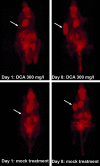DCA promotes progression of neuroblastoma tumors in nude mice
- PMID: 25973318
- PMCID: PMC4396043
DCA promotes progression of neuroblastoma tumors in nude mice
Abstract
Even in the presence of oxygen most cancer cells convert glucose to lactate via pyruvate instead of performing oxidative phosphorylation (aerobic glycolysis-Warburg effect). Thus, it has been considered to shift pyruvate - the metabolite of aerobic glycolysis - to acetylCoA by activation of pyruvate dehydrogenase (PDH). AcetylCoA will then be metabolized by oxidative phosphorylation. Therefore, the purpose of this study was to shift tumor cells from aerobic glycolysis to oxidative phosphorylation using dichloroacetate (DCA), an inhibitor of PDH-kinase. The effects of DCA were assayed in vitro in Neuro-2a (murine neuroblastoma), Kelly and SK-N-SH (human neuroblastoma) as well as SkBr3 (human breast carcinoma) cell lines. The effects of DCA on tumor development were investigated in vivo using NMRI nu/nu mice bearing subcutaneous Neuro-2a xenografts. For that purpose animals were treated continuously with DCA in the drinking water. Tumor volumes were monitored using caliper measurements and via [18F]-FDG-positron emission tomography. DCA treatment increased viability/proliferation in Neuro-2a and SkBr3 cells, but did not cause significant alterations of PDH activity. However, no significant effects of DCA could be observed in Kelly and SK-N-SH cells. Accordingly, in mice bearing Neuro-2a xenografts, DCA significantly increased tumor proliferation compared to mock-treated mice. Thus, we could demonstrate that DCA - an indicated inhibitor of tumor growth - efficiently promotes tumor growth in Neuro-2a cells in vitro and in vivo.
Keywords: Dichloroacetate; Neuro-2a mouse model; Warburg effect; [18F]-FDG uptake; cell proliferation.
Figures




Similar articles
-
Lipoic acid inhibits cell proliferation of tumor cells in vitro and in vivo.Cancer Biol Ther. 2012 Dec;13(14):1425-35. doi: 10.4161/cbt.22003. Epub 2012 Sep 6. Cancer Biol Ther. 2012. PMID: 22954700 Free PMC article.
-
Influence of dichloroacetate (DCA) on lactate production and oxygen consumption in neuroblastoma cells: is DCA a suitable drug for neuroblastoma therapy?Cell Physiol Biochem. 2012;29(3-4):373-80. doi: 10.1159/000338492. Epub 2012 Apr 3. Cell Physiol Biochem. 2012. PMID: 22508045
-
Multi-modality imaging to assess metabolic response to dichloroacetate treatment in tumor models.Oncotarget. 2016 Dec 6;7(49):81741-81749. doi: 10.18632/oncotarget.13176. Oncotarget. 2016. PMID: 28082726 Free PMC article.
-
Dichloroacetate and cancer: new home for an orphan drug?Biochim Biophys Acta. 2014 Dec;1846(2):617-29. doi: 10.1016/j.bbcan.2014.08.005. Epub 2014 Aug 23. Biochim Biophys Acta. 2014. PMID: 25157892 Review.
-
The Importance of Gender-Related Anticancer Research on Mitochondrial Regulator Sodium Dichloroacetate in Preclinical Studies In Vivo.Cancers (Basel). 2019 Aug 20;11(8):1210. doi: 10.3390/cancers11081210. Cancers (Basel). 2019. PMID: 31434295 Free PMC article. Review.
Cited by
-
GlucoCEST MRI for the Evaluation Response to Chemotherapeutic and Metabolic Treatments in a Murine Triple-Negative Breast Cancer: A Comparison with[18F]F-FDG-PET.Mol Imaging Biol. 2022 Feb;24(1):126-134. doi: 10.1007/s11307-021-01637-6. Epub 2021 Aug 12. Mol Imaging Biol. 2022. PMID: 34383241
-
Targeting glucose metabolism in cancer: new class of agents for loco-regional and systemic therapy of liver cancer and beyond?Hepat Oncol. 2016 Jan 1;3(1):19-28. doi: 10.2217/hep.15.36. Hepat Oncol. 2016. PMID: 26989470 Free PMC article.
-
Enhanced nanoparticle delivery exploiting tumour-responsive formulations.Cancer Nanotechnol. 2018;9(1):10. doi: 10.1186/s12645-018-0044-6. Epub 2018 Nov 21. Cancer Nanotechnol. 2018. PMID: 30595759 Free PMC article. Review.
-
Dichloroacetate affects proliferation but not apoptosis in canine mammary cell lines.PLoS One. 2017 Jun 7;12(6):e0178744. doi: 10.1371/journal.pone.0178744. eCollection 2017. PLoS One. 2017. PMID: 28591165 Free PMC article.
-
Dichloroacetate for Cancer Treatment: Some Facts and Many Doubts.Pharmaceuticals (Basel). 2024 Jun 6;17(6):744. doi: 10.3390/ph17060744. Pharmaceuticals (Basel). 2024. PMID: 38931411 Free PMC article. Review.
References
-
- Stacpoole PW, Nagaraja NV, Hutson AD. Efficacy of dichloroacetate as a lactate-lowering drug. J Clin Pharmacol. 2003;43:683–691. - PubMed
-
- Pan JG, Mak TW. Metabolic targeting as an anticancer strategy: dawn of a new era? Sci STKE. 2007;2007:pe14. - PubMed
-
- Stacpoole PW. The pharmacology of dichloroacetate. Metabolism. 1989;38:1124–1144. - PubMed
-
- Gatenby RA, Gillies RJ. Why do cancers have high aerobic glycolysis? Nat Rev Cancer. 2004;4:891–899. - PubMed
LinkOut - more resources
Full Text Sources
Research Materials
